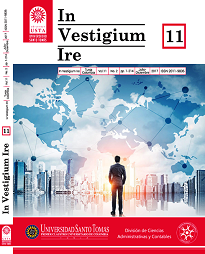Análisis empresarial en crecimiento y desarrollo regional de Bogotá DC y municipios estratégicos de Cundinamarca
Contenido principal del artículo
Resumen
En este artículo, se presenta una aproximación conceptual de crecimiento y desarrollo regional de acuerdo a la dinámica empresarial de la articulación Bogotá DC y municipios estratégicos: Facatativá, Madrid, Funza y Mosquera, su aporte al PIB nacional, departamental, municipal y per cápita. Revisión de sectores, actividades, demografía de la región, como las modalidades de empresas, extensión y su ubicación territorial.Se busca determinar cómo la dinámica empresarial de la zona Bogotá DC y los municipios estratégicos de sabana de occidente, transforman la dinámica socioeconómica, territorial, desde el punto de vista urbano y rural; y la influencia del POT en las políticas del uso, tenencia, destinación y precio de la tierra.La movilidad humana o migración del campo hacia la ciudad, tanto, nacional como internacional, en especial, el caso de Venezuela, el cual viene creciendo y modifica la base demográfica por medio de cambios en políticas sociales e integrales, entre ellos, las posibilidades de fuentes de trabajo de acuerdo a los sectores y actividades organizacionales (empresas) locales, como las que han llegado a la región, trasladadas de Bogotá DC y su impacto en la transformación regional de la economía.
Detalles del artículo
Cómo citar
Piraquive-Cortés, A. (2018). Análisis empresarial en crecimiento y desarrollo regional de Bogotá DC y municipios estratégicos de Cundinamarca. In Vestigium Ire, 11(2), 113-131. Recuperado a partir de http://revistas.ustatunja.edu.co/index.php/ivestigium/article/view/1553
Número
Sección
Artículos Núm. 11-2
Investigium Ire de http://revistas.ustatunja.edu.co/index.php/ivestigium esta bajo una licencia Creative Commons Reconocimiento-NoComercial-SinObraDerivada 4.0 License.
Citas
Arcos Palma, O.(2008). Teorías y Enfoques del Desarrollo. Escuela de Admnistración Pública. Bogotá, Colombia.
Cámara de comercio de Bogotá (CCB). (2017). Dirección de gestión de conocimiento. Recuperado de Tablero de indicadores Bogtá - Cundinamarca: http://www.ccb.org.co/
Carvajal,Burbano , A. (2011). DESARROLLO LOCAL,Manual Básico para Agentes de Desarrollo Local y otros Actores (Vol. Primera edición digital). Málaga, España, Recuperado de eumed.net.
Esqueda, W. (2013). Economías de la aglomeración en el contexto de la nueva geografía económica. Contribuciones a la economía, 18.
Gaviria Rios,M. (2010). Apuntes de Economía Regional. Pereira, Risaralda, Colombia: Universidad Católica Popular del Risaralda.
Gobernación de Cundinamarca. (2016). Secretaría de Planeación de Cundinamarca. Recuperado de Oficina de Sistemas de Información Análisis y Estadísticas: http://www.cundinamarca.gov.co/
Gutierrez Casas, L.(2006). Teorías del Crecimiento regional y el desarrollo divergente. Revista de ciencias Sociales y Humanidades, 164.
Gutierrez Casas, L.(2006). Teorías del crecimiento regional y el desarrollo divergente. Propuesta de un marco de referencia. Nóesis. Revista de Ciencias Sociales y Humanidades, 185/227.
mheducatión.es. (s.f). La empresa y su organización 01. mheducatión.es, 39.
Real academia de la lengua española (RAE). (2017). conceptos. Recuperado de http://www.rae.es/recursos/diccionarios.
Cámara de comercio de Bogotá (CCB). (2017). Dirección de gestión de conocimiento. Recuperado de Tablero de indicadores Bogtá - Cundinamarca: http://www.ccb.org.co/
Carvajal,Burbano , A. (2011). DESARROLLO LOCAL,Manual Básico para Agentes de Desarrollo Local y otros Actores (Vol. Primera edición digital). Málaga, España, Recuperado de eumed.net.
Esqueda, W. (2013). Economías de la aglomeración en el contexto de la nueva geografía económica. Contribuciones a la economía, 18.
Gaviria Rios,M. (2010). Apuntes de Economía Regional. Pereira, Risaralda, Colombia: Universidad Católica Popular del Risaralda.
Gobernación de Cundinamarca. (2016). Secretaría de Planeación de Cundinamarca. Recuperado de Oficina de Sistemas de Información Análisis y Estadísticas: http://www.cundinamarca.gov.co/
Gutierrez Casas, L.(2006). Teorías del Crecimiento regional y el desarrollo divergente. Revista de ciencias Sociales y Humanidades, 164.
Gutierrez Casas, L.(2006). Teorías del crecimiento regional y el desarrollo divergente. Propuesta de un marco de referencia. Nóesis. Revista de Ciencias Sociales y Humanidades, 185/227.
mheducatión.es. (s.f). La empresa y su organización 01. mheducatión.es, 39.
Real academia de la lengua española (RAE). (2017). conceptos. Recuperado de http://www.rae.es/recursos/diccionarios.


